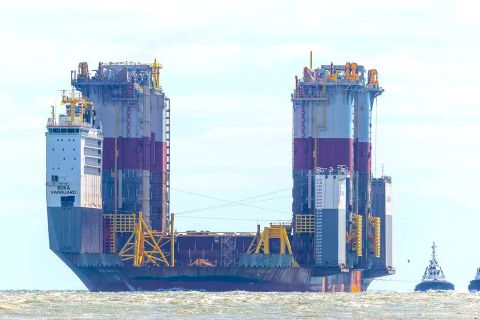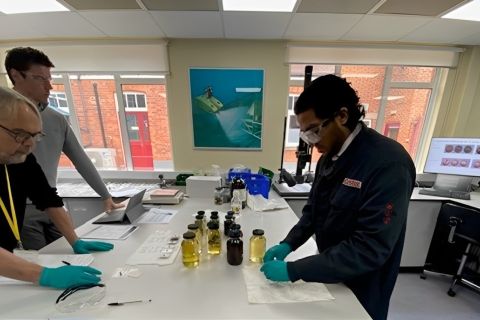The U.K. is going through a historical phase as a hydrocarbon-producing country. After having relied on small entrepreneurs for the development of its onshore underground oil and gas wealth, it let the state-owned and private majors take care of the major risks and the colossal investments required for the exploration and development of its offshore resources. BP, the chief explorer and producer, expanded its reserve base, financial wealth and experience enormously thanks to its 35 years of active presence in the basin. As a state-controlled organization, BP contributed greatly to the U.K.'s economic growth and its global stance as an oil and gas producer during these three decades while the company grew to become the second-largest oil and gas operator in the world. Meanwhile, Shell also expanded its activities throughout the U.K. offshore oil and gas development, alongside many of the largest European E&P operators, who, at different stages of their lives, moved into the U.K. Continental Shelf (UKCS) to grab the rewards, and the thrill of the North Sea. Today, BP, still the key major operator of the basin, accounts for more than 15% of the drilling activity (comprised of exploration, appraisal and production wells) and more than 15% of the U.K. North Sea total investment. The super-major reckons that it continues to have 4.5 billion barrels of oil and gas to extract from the North Sea. BP has also redeployed its activities on a number of other core areas, dubbed "strategic profit centers," in Angola, Azerbaijan, the deepwater Gulf of Mexico, Trinidad and Asia-Pacific LNG. BP is also looking at strengthening its global position by working on major projects including in Russia, through the TNK joint venture. But despite such major strategic redeployments, the U.K. North Sea still accounts for around 20% of its oil and gas production and is expected to remain a major part of its business even when the new areas go into production in the years ahead. New entrants inland The North Sea has recently offered the opportunity of adventure to a number of smaller producers. Although the ticket to enter the U.K. offshore is expensive, the last decade has been particularly fruitful for the smaller player, as industry consolidation has released a lot of human resources very willing to use their skills, experiences and networks to join the fray. Former BP, Shell, Exxon and Conoco personnel have joined forces and started a number of oil and gas minnows that are now at the forefront of the British independent sector. These early movers are now mostly in the production stage and their success has been emulated. The recent 21st offshore licensing round is in itself a testimony to that, as 36 out of the 75 applicants were total newcomers to the U.K. offshore, and were comprised mainly of business ventures set up to join the independent sector or new entrants with previous experience in other basins. Eventually 27 new entrants were awarded licenses out of the 62 distributed in total. Alongside this offshore round, the 11th onshore licensing round was held, where eight licenses were awarded. Total inland production cannot rival in any way the offshore figures. Onshore fields have yielded more than 25 million tons between 1975 and 1995, when a steep decline in yearly production set in. Production in 1996 was 5 million tons; in 2002, it was 2.6 million. This was from 24 fields. During the same period, the offshore U.K. was producing 1.8 billion tons; in 2002, it yielded 105 million. In the 1980s, a tax scheme allowed oil companies to offset their onshore exploration costs against their offshore costs. A robust inland exploration campaign followed, driven by the majors, which struck some interesting discoveries like the mega-field Whytch Farm, thought to contain 350- to 500 million recoverable barrels, and today still yields more than 2 million tons of crude per year. With the withdrawal of tax relief however, the larger companies made room for their smaller U.S. and U.K. counterparts. Though unable to maintain the previous levels of production, these assets nevertheless still offered some room for much more entrepreneurial types of ventures. The U.K. onshore activities offer much less risk than their offshore cousins, and the rewards can be great. There have been 46 onshore discoveries since 1983, most of them generated by the tax incentive. Recently, the good news has been provided by the smaller independents. In August 2003, Pentex Oil UK announced a discovery of more than 100 million barrels of oil equivalent on farmland at Avington, near Winchester, Hampshire. The privately owned company, which also has interests in the Balmoral Field in the North Sea and operates wells in Hampshire and the East Midlands, says the find is at least 30% larger than its biggest existing U.K. reserve, 15 miles away. Pentex claims to be the U.K.'s third-largest onshore supplier of oil, behind Star Energy and market leader BP, and its find, thought to be the largest onshore Britain discovery in the last two decades, has triggered renewed interest in the inland basins. A number of very interesting operators emerge from the onshore operating picture. Star Energy, today the second-largest inland producer after BP, has developed a unique model of oil and gas production and independent energy generation, acquiring four gas turbines generating 25 megawatts from gas that was previously flared. The company is now exploring possibilities for new business developments. With the company's oil fields moving into depletion and the expected future growth in demand for gas storage, Star Energy is currently developing gas-storage projects in its declining oil fields. It is also working on a wind farm, comprised of 14 wind generators in four locations, epitomizing the birth and rise of homegrown multi-activity energy organizations. Other small operators are looking at such examples of success with a mix of envy and confidence. Midmar Energy, a dynamic operator with experience onshore, is looking towards the company's next leap forward. Already working to redevelop five mature onshore assets in different parts of the U.K., the company has recently benefited from the government's push to help the U.K. offshore get a second wind. The "promote" licenses, first offered to the industry during the 21st licensing round in February 2003, are among the critical reasons for the round's success. They grant developers two successive two-year periods, the first dedicated to exploration, followed by two years for development. During the first two years, the company exploring the license will pay reduced rental fees for the acreage, and at the end of this period will decide whether to drill the prospect, or to drop it. Midmar Energy grabbed an offshore license under these terms with venture partner Providence Resources. This foray offshore the U.K. builds on the development of the company's onshore portfolio. Besides its rewarded participation in the 21st offshore licensing round, Midmar is planning to drill a very promising offshore prospect in 2004 with its partner and license operator, Providence. Black Rock is in the Celtic Sea, offshore Ireland, and "could be our jewel in the crown," says Midmar chairman P.J. Redman. Several other onshore players are emulating these examples. Odiham, Hampshire-based Egdon Resources is, for instance, technology-driven, looking at applying PC-based software tools and applying workstation technology to reprocess seismic data. The company is looking at assets that weren't correctly tested or drilled and aiming to realize their value at lower costs. It is also a 20% partner in Pentex's major Avington find and this should provide it with a welcome line of cash flow. And there is more potential ahead. With the rather brutal stop in exploration activity following recent tax changes, a lot of "half-done" work is available. "One of the opportunities in onshore U.K. is the fact that data is very widely available, through the U.K. onshore geophysical library and reprocessing the data is largely facilitated," says Mark Abbott, Egdon Resources joint managing director. "The U.K. onshore industry attracts small companies, as virtually no major or even medium-size companies are present in this area, and the costs are low." Andrew Hindle, second joint managing director, adds, "The main problem faced by companies like ours onshore is that there isn't the level of drilling activity that would drive the prices down for oilfield services and make the onshore U.K. really attractive." Independents offshore For some independents, onshore operations provide a springboard to offshore ambitions, where levels of production and reward can dwarf inland operations. Since the beginning of the offshore rush, 294 fields have been approved for production, out of which 275 were approved after January 1976. Today, there are 151 offshore oil fields in production, yielding between 5,000 and 5.3 million tons per year (like the Schiehallion Field operated by BP). Besides the majors, a few independents are making a name, leading the pack and opening the way. Venture Production, an independent, was successful in acquiring assets from Shell and Conoco. It is focusing on brown-field investments, in securing cash flow-generating producing assets, and exploring the fringes to reduce risk. The company is looking at releasing new volumes and reserves through the drillbit and has been investing heavily in the last years, capitalizing on these brown-field opportunities. Venture Production managing director Bruce Dingwall, who is also president of the U.K. Offshore Operators Association (UKOOA), says, "It has taken a while for big companies to start rationalizing their portfolios. Promote licenses, a very welcomed novelty, are a joint initiative of industry and the Department of Trade and Industry (DTI). "Today is a time when more appropriate operators are moving in the U.K. basin because of the materiality of assets to be found in the U.K. Continental Shelf. We are, for instance, quite happy to drill 10- to 20-million-barrel-of-oil-equivalent prospects, while big companies cannot do it, as it doesn't impact their bottom line." After the acquisition of the Kittiwake assets and infrastructure from Shell, the company signed a duty-holding agreement with service provider and facilities management operator Petrofac. This partnership with service operators builds on a strong tradition of cooperation among oil companies to work cost-efficiently in the basin. It was started when Shell and Exxon teamed in the 1980s. The North Sea partnership approach is unique, often featuring groups of up to 10 partners, all of them equity participants in an asset, and nevertheless achieving, in most cases, great levels of efficiency. This may create some sort of cultural shock for North American companies willing to enter the basin, says Nick Hooke, executive director of asset-management consultancy Challenge Energy Ltd. "Most North Sea ventures are multi-company partnerships and therefore decision-making is taken by a group of companies, each with their own business agenda and processes. Most American E&Ps are used to owning 100% of a license and are consequently not used to anyone interfering with their decision-making." Opportunities abound for medium-size companies like Venture, Palladin Resources and Tullow Oil. Dingwall says, "It is a great time to invest here, but very few people actually are. We aren't opportunity-strained in the basin." Tullow Oil chief executive Aidan Heavey adds, "In our case, as well as in a few others, our experience abroad has been very helpful in defining new approaches in the North Sea. There used to be a 'big company' approach to the sector, usually synonymous with expensive and rather slow. "In the old days, fields were being shut down for a month for maintenance while it is now an ongoing process achieved without any shutdown. "There is also a very cooperative approach between smaller players, trying to share costs and cut overheads by putting in common facilities, sharing transportation costs, and such. The industry is changing, and after watching the majors gobble up independents during the past five years, we can now see the majors breaking up into small independents, as the sizes of projects are much more suitable for smaller operators." Many opportunities are opening up for total newcomers, especially on the more marginal side of the business. Promote licensee Corsair Petroleum, without linkage to its North American cousin, is for instance looking at developing an asset thought to contain heavy oil, therefore calling for different expertise than in most of the rest of the basin. But the partners behind the venture are very confident that their combined experiences across the scope of offshore petroleum exploration and production will turn Corsair into a successful company, should its licensed asset hold its promises and the quest for partners bring to the company a successful combination of expertise and financing. "Looking at the Gulf of Mexico, you can see a lot of small companies developing assets and developing value that the majors might not even see. One of our advantages here is that we are home-grown and therefore know about the pitfalls of the U.K. sector," says Simon Gorringe, Corsair Petroleum managing director. Xcite Energy Resources, on its side, is looking at appraising a reservoir also acquired under the promote initiative during the 21st round and taking it through development. Its license covers an asset in the northern North Sea that has been proven to contain huge volumes of oil-around 650- to 700 million barrels, according to DTI estimates. The main question mark concerns the quality of the oil, which has never been fully tested. Here again, a group of entrepreneurs is teaming to generate value on a proven, but untested, field, and are now looking at finding the most suitable approach to test the block with a strong view to developing it, most probably with partners. Another interesting innovation is epitomized by Tuscan Energy, also a newcomer to the basin. Looking at brown-field opportunities, Tuscan was awarded a license for an abandoned field. The main novelty in this case is the fact that, highlighting the DTI's commitment to lateral thinking and innovation, it awarded Tuscan an operator license without it having any previous experience. Tuscan's Dave Workman says, "But that also implied a lot of work on our side to present a good field-development plan contained directly in our license application. We are now working on redeveloping the field and will go on with drilling throughout 2004, drilling high-angle wells at 60 to 70 degrees instead of the original vertical wells." The company's model seems to hold a brilliant future, as the first well drilled and commissioned started flowing at rates of up to 20,000 barrels of oil per day, proving the worth of the business plan. About this project, Stephen Timms, energy minister, says, "This is excellent news for the North Sea. Government and industry have worked closely to ensure that the UKCS is still an attractive place for exploration and development. The revival of this once dead field shows this collaboration is working." Challenges ahead Yet, despite such successful examples and innovative approaches, difficulties remain. With high oil prices and the majors looking at maximizing the value of their assets when they farm out their interests, acreage doesn't go for a bargain. Apache Corp.'s recent acquisition of BP's 96.14% interest in the Forties Field exemplifies that. Described as a win-win for the North Sea by the energy minister at the time, the sale triggered a lot of interest from the U.S. and was well received by the financial markets. Discovered by BP in 1970, the Forties Field is the largest ever found in the U.K. sector of the North Sea, and still ranks eighth in production and reserves after having produced approximately 2.5 billion barrels to date. Apache's acquisition economics estimate average 2003 production of 45,100 barrels of oil per day and net proven reserves of 147.6 million barrels. This deal should underline the fact that with more reasonable prices per barrel, the deal flow could increase considerably in the months and years ahead, notably featuring more asset deals between smaller companies. The acquisition also epitomizes one of the issues highlighted by some UKCS players that may help to explain the sluggish pace of investment from independents. From the sale of Forties, BP retained ownership over the pipeline infrastructure tied to the field's production. This decision makes perfect business sense, as it is an economically viable infrastructure with a potential for tie-backs into the pipeline from operations in the vicinity in the years ahead. With most of the pipeline infrastructure in the hands of the majors, smaller players are very prompt to denounce the big companies' abuses of their dominant position, or indeed monopolistic posture and their lack of understanding in defining win-win access tariffs positions. When looked at closely, the situation isn't so dramatic and most of the problems encountered are actually down to delays in putting a deal together. However, the DTI has taken into account some of the concerns of the industry and has worked closely with some of its representatives to put together an infrastructure access code, formalizing relationships and conditions of access between infrastructure owners and producers. The issue of decommissioning of played-out fields has also been presented as a potential headache in the basin, as some of the infrastructure in place is more than 20 years old. The cost of abandonment could be a potent deterrent for new entrants who might not have the financial shoulders to bear it. A number of innovative approaches have been adopted to tackle the decommissioning problem. In some cases, majors like BP and Shell have transferred their assets and infrastructures to U.K. minnows while agreeing to retain the cost of abandonment. Obviously, the majors have made provisions to take abandonment into account, but are also expecting that the transfer of ownership will delay the end of a field's life and the associated costs of decommissioning for as long as possible. Finally, the major hindrance to the successful second wave of development of the U.K. oil and gas industry, and most notably of its offshore dimension, is the release by the majors of fallow acreage, exploration blocks, proven discoveries, brown fields and other assets lying undeveloped and waiting for the right combination of risk-taking and innovative thinking. Here again, things are moving in the right direction, as the industry and the DTI are cooperating in the so-called "fallow field initiative," to release more acreage and opportunities for smaller players to enter the fray. The ball is now in the camp of the majors, who retain rights on most fallow acreage and are widely expected to move ahead speedily to give the basin more room for growth. These issues are being tackled efficiently and the North Sea picture is becoming rosier by the day. U.K. independents have interesting, and rewarding days, months and years ahead. Onshore, the picture is filled by small entrepreneur-driven companies, some of them already with very sizeable operations. The innovative approach preferred by most of them has been proven successful in many cases and one can expect more in the years ahead. It may be fuelled by increased levels of cooperation among U.K. and North American companies, and applied to the problem of mature onshore oil and gas production. This could in turn fuel even more deregulation, liberating a sector that is still kept under check by local regulatory framework and the local population's aversion to oil production. Offshore, the picture is even more exciting. After years of disillusionment, the U.K. North Sea is addressing the challenge of production decline in a whole-hearted manner. Great ideas are coming to life, newcomers are showing enthusiastic interest and the U.K. government has proven its will to sustain the momentum and extend the basin's life term by increasingly knocking down barriers to entry. It is now the turn of the operators to demonstrate their commitment to a secure, yet costly, area of operation. With the application of technology and the coming together of experiences from the North Sea and other mature basins like Canada or the Gulf of Mexico, the North Sea should retain its status as a major producer for at least a decade to come.
Recommended Reading
SLB OneSubsea JV to Kickstart North Sea Development
2024-05-07 - SLB OneSubsea, a joint venture including SLB and Subsea7, have been awarded a contract by OKEA that will develop the Bestla Project offshore Norway.
Chevron, Total’s Anchor Up and (Almost) Running
2024-05-07 - During the Offshore Technology Conference 2024, project managers for Chevron’s Anchor Deepwater Project discussed the progress the project has made on its journey to reach first oil by mid-2024.
Electric Hype vs. Hydraulic Reality: Advantages of Traditional Systems
2024-05-07 - Castrol's new fluid prevents gas hydrates in deepwater control systems.
EOG: Utica Oil Can ‘Compete with the Best Plays in America’
2024-05-06 - Oil per lateral foot in the Utica is as good as top Permian wells, EOG Resources told analysts May 3 as the company is taking the play to three-mile laterals and longer.
E&P Highlights: May 6, 2024
2024-05-06 - Here’s a roundup of the latest E&P headlines, including technology milestones and new contract awards.





